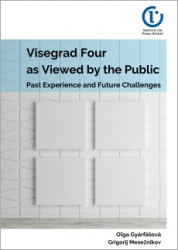This is the archival site of the former V4 portal. As of July 2024, it is no longer updated.
Visit visegrad.group for the current website.
Visit visegrad.group for the current website.

Thu 8 January 2026
Warszawa (PL)
4/2°C
| Tue | Wed | Thu | Fri | Sat |
|---|---|---|---|---|
| 1 | 3 | 5 | 6 | 8 |
Thu 8 January 2026
Praha (CZ)
6/2°C
| Tue | Wed | Thu | Fri | Sat |
|---|---|---|---|---|
| 6 | 5 | 8 | 8 | 9 |
Thu 8 January 2026
Bratislava (SK)
6/-1°C
| Tue | Wed | Thu | Fri | Sat |
|---|---|---|---|---|
| 8 | 6 | 7 | 8 | 8 |
Thu 8 January 2026
Budapest (HU)
5/-2°C
| Tue | Wed | Thu | Fri | Sat |
|---|---|---|---|---|
| 6 | 6 | 6 | 9 | 8 |
When Is a City a Central European City?
The "Here and Now" and the Utopia of Everyday Life
by Tamáš Tofalvy
If someone pours over a map looking for the place we call Central Europe, whether or not they are au fait with the condition known as Central Europeanness, whether this culture is theirs or not, they have no outline map to rely on.
Without national borders, the sparse veins that enmesh the body of Europe, the outside observer would most probably draw on the help of proportions and look for Central Europe where the Russian plains begin, while those who know very well where to look can be taken aback: their instincts were fed not by geographical forms, often considered exclusive providers of meaning, but by a knowledge of borders and the presence of a deep-set political awareness.
This instinct can become all the more obvious and thereby insecure if they have to navigate by recourse to the dots inside the web of borders, the cities, for it is in the tension between the roles marked by the geographical pattern and the histories formed by the political map that all those things are produced which guarantee the special place of cities in getting to know the world, and which give the Central European city its peculiar role in our culture.
The person searching for Central Europe has thus far navigated using the points of the compass, the uneven surface of the continent, and the lines of national boundaries, looking to answer the question 'Where is it?', but the need to conform to political circumstances makes more and more possible worlds unfold before their eyes, continuously expanding the forms of space with every change in time. If they find the city, have they actually found the city itself? Which city have they found, if they happen to have found it now? And if there can be a distinction, if there is a distinction, how can we locate the concept of the Central European in space as it develops and time as it changes? Put simply: when is a city a Central European city?
Maps, Times, Cities
'Right now, of course!' might be the response of someone used to questions like this. But this response, no doubt relevant to the phenomenology of survival, is no longer adequate if we wish to answer the question of how the experience of the city "here and now" is built up on cityscapes, symbols, communities and life stories that have been built, destroyed, planned or simply patched together over hundreds of years, and how the way one moment follows the last can lead to the establishment of desires, expectations and examples.
Yet it is precisely amidst this tension, in the space between a given heritage and changing expectations, that the condition and culture known as Central Europeanness has obtained and continues to obtain its ever-changing character: in the cities built at a different time and in a different place, but which we inhabit here and now, and gearing up for a role played at a different time and in a different place, the condition of continuous preparation, of forever being in-between things.
We could say that the same is true of all points on the compass: cities, like countries in general, developing on the basis of changing principles and changing habits, are but tradition and extrapolations of tradition; room for manoeuvre and possibilities that arise are a given. Yet it is precisely this universal model which directs attention to how varied are the traditions and opportunities, pasts and paradigms that collide with one another in the experience and interpretation of a particular geographical, cultural or urbanistic formation.
So what is it that makes it so difficult to separate the times and spaces that accumulate in the community of a Central European city? If again we look at the map, not at today's map, but if we reach up to a long-forgotten shelf thick with dust and take down a depiction of what Europe once was, we see the surface of the continent divided up by rivers and hills before established borders were laid down, we see the Latin names of the more important cities, then, turning the pages further through the centuries, we are faced with the series of maps essentially presenting Central Europe as within the boundaries of the Habsburg Empire.
The names of the cities here mostly appear in German, signifying the shift brought about by the reinterpretation of tradition and within the boundaries of the changed expectations that resulted from this: an empire integrates geographic units in a political sense, too, and the roles and functions of cities - that is their own expectations and what is expected of them - obtain meaning within the framework of the empire.
This interpretation is the first direct precursor of the strategy that is responsible for the ambivalence of the temporality of today's Central European city. In the fabric of the cities held together by the empire (that is a space that can be delimited absolutely, precisely and in every direction), it became inevitable, as in any other empire, that regional, development and political anomalies would become increasingly distinct and characteristic. The cities, located at various points in space, increasingly became defined according to whether they belonged to the economic, religious and political centre, or to the periphery, or indeed to somewhere in the broad expanse in-between the two.
Thanks to this, the dimension of time as progress is given more and more opportunities in political thought - which in any case is only a cognitive product of the eighteenth century - or, to put it another way, in Central European regional thinking. The obligation to adjust to the central cities marked as models led to the further distancing of the growing number of other cities forced to follow the often inescapable roles associated with the periphery. Distancing, as the metaphor of spatial distance, became included in the freshly-developed notion of progress; distancing, as space tore apart the circumstances of the cities from what was considered ideal; distancing from the paths of autonomous progress determined by the necessities of the cities' narrower environment and from the interpretations of their inhabitants and leaders, which was now only able to see the possibility of new development, the promise of the future, in a single geographical direction, the symbol embodied by the centre.
This hermeneutical disparity - similar to the changes to the study of signs following the Renaissance, which broke the given and inevitable connection between a phenomenon and its meaning - destroyed for good the unity of a city's present and future, to the extent that this new-fangled pair of terms no longer found their ideal representation in space. While the present was still attached to the "here and now", the future, connected to the concept of progress, was looking for everyday utopia elsewhere, in the centre.
The Compulsions of the Future
This was not an insignificant factor in the decline of the cohesion of the empire, followed by its seemingly sudden collapse - which gave Central Europe cities new centres and new visions for the future. But these visions for the future could not be part of an increasingly prevalent linear principle of progress determined by historical continuity, if for no other reason than because the traditions underlying them had fallen to pieces. The individual histories of the so-called nation-states, taken from one another and rewritten and reinterpreted, ripped right through the spaces and future visions of the common past.
With the disappearance of the empire and the appearance of many little borders, the attitude to progress increasingly favoured regions considered more developed than the area demarcated by the geographic situation of the former empire, increasingly allowing the West to crystallize as a network-like metaphor of the unit of measure, objective and meaning of progress. For the regional system of relationships to fall into a larger system, the West, born for real with the West's decline, was, in the narratives of the little Central European countries, no longer an alternative, it was the only alternative.
After the war, the machinery of capitalism, burdened with crises, and the establishment of national economies dependent on the big Western economic centres, were unable to shield themselves from the deathly diseases of the West: a succession of Central European states, also actively participating in the war and the genocide, could not separate itself from the traditions discarded by the Second World War and the Holocaust or from the Nazi totalitarian state's offensive visions of the future.
For the inhabitants of the region, the war brought suffering and destruction on an unprecedented scale, while its end presented a previously inconceivable opportunity for reckoning. What happened? The urban structures, still largely defined by the economic opportunities of the empire and the role played within it, which had just begun to test themselves between the borders of small states, and in orientating themselves towards Europe, now lay scattered in ruins in the centre of the Old Continent.
And yet, the ruins proved to be stronger than those guiding the hands of those rebuilding them, not that this could have been any other way: as long as visions of the future can be little more than extensions of the past, only retrospective speculations can bring satisfactorily unjust judgments. Despite the fact that the Second World War finally dismantled the structure of the empire, the cities were reconstructed anew rather than transformed into something new. So too was Budapest rebuilt, the Budapest that had once been the rival of the imperial capital and the empire's second city, a city near the northern perimeter of a tiny country, not at all prepared for the fact that this reconstruction would not only no longer be able to conform to a Western model imagined on the basis of ideas from the past, but would soon be determined by a new type of model which no one in this half of Europe desired.
It is difficult, not just in the list of "heres and nows", but even equipped with the benefit of hindsight, to comprehend the severance of Central Europe from the Western utopia, and to attach writings representing its desires to a geographical direction which, as a sort of duplication of reality, never stood for the progress which it was nevertheless continuously able to produce and impart when it came to formations of terror and rhetoric. The triumph of force over the utopia of experience left the Central European cities with a legacy that long decades will not be able to erase from either their past, their present, or, for that matter, their future.
With the easing of the force of central control, and in the swing of the changes of regime, cities that were again increasingly turning towards a different, economically more advanced world suddenly found themselves "there" and yet also "here", confusing the cheapest, most readily available décor of freedom with the opportunities for free trade and thought. The cities of Central Europe have not climbed out of this predicament to this day, despite the fact that, with the passing of more than a decade and half, they have become part of the newer closed territorial unit of the European Union, formerly considered a complete utopia, and now increasingly doubted as such.
And little could we expect these cities to live and operate according to their own past and future, a past that is once again not applicable: cities which once boomed or declined according to the anomalies of the blood flow through the empire, then which obtained what continues to remain their architectural character from the eclectic urban development concepts of the fin de siècle, a road network in existence before the first automobile, cities equipped with enormous public buildings, which lost their economic and cultural context in small nation-states only to function as living monuments, and which under the communist dictatorship were symbolically turned to face a new centre, only to be pointed back again.
Almost every element of the Central European city is a memento of the past, of a past that documents a role that no longer exists anywhere today, a role that nostalgic strategies often present as desirable. More recent features - from the development of public transport to the organization of events and the reconstruction of façades - again point the attention of planners in the direction of the economic utopia of the area delimited by the European Union, of the West, and as such these planners yet again find themselves on the periphery of another big system.
Where Are You?
For the inhabitants of Central European cities, the multitude of communication, economic and political channels provided by the collection of changes referred to as globalization, unfolding essentially in tandem with European integration, is at once the engine of and alternative to a turn towards the West and away from local solutions for the local space.
As theorists and practitioners of globalization have repeatedly pointed out: under globalization, it is not only the leading models of behaviour that can attain ever greater publicity, but individual regions have more and more opportunity to communicate information about their existence and their model to other places, thereby defining and identifying themselves, not as establishing a relative position, but in this case as an alternative goal, not escaping from the past, but reaching back to it, not following tradition, but reinterpreting it.
Why is this all significant? Not because of national interests: it was precisely the fate of Central Europe which showed of these that it is only for the "winner" that they present an alternative. Not because of regional peculiarities: all regions are as interesting as one other; difference and the construction of the exotic almost always develop out of distance and the unknown rather than essential originality. Not because of economic interests: employment can equally be generated or economic indicators improved by a multinational company as by a local one.
No, for it is precisely along these webs of interests that the West as an alternative for the future became what it is, which immediately raises the question: is it possible for Central European cities, having ended up in different political communities, which, though they continue to exist within the structure provided by the former nation-states, whose fragmentation has meant that they have forever lost their function as powers, or at least partially, within the structure of the current great power, still to determine their future within their own space and own sphere of opportunities?
If it proves possible to establish the sphere of opportunities in not only an economic but a wider cultural sense, through rethinking own choices and decisions, then the answer, with the expression of hope rather than hermeneutical suspicion, is yes. And then the future can indeed, and not just in distant regions, be "here" and "now".







